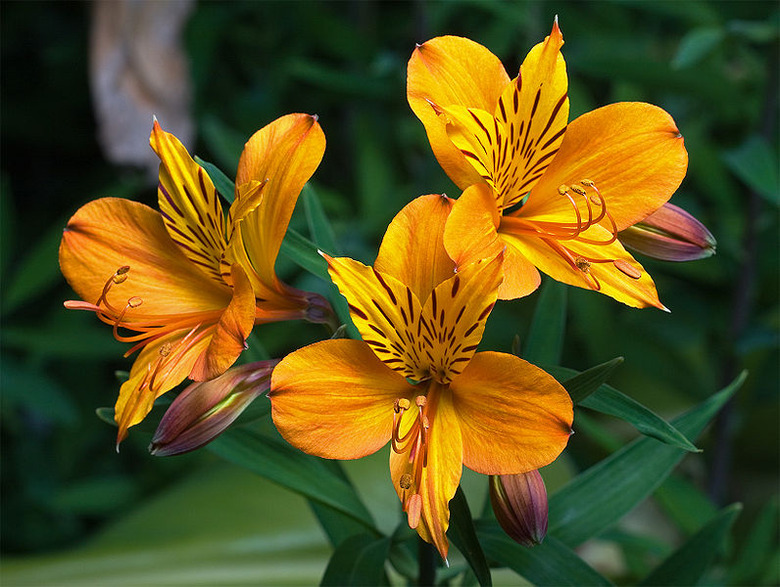Care For Alstroemeria
Things Needed
- Water
- Water soluble fertilizer
- Organic mulch
- Secateurs
- Staking
Tip
While not a strong attractant to pests, alstroemeria can beckon slugs in the garden. Laying down a couple of low saucers of beer for consecutive nights can alleviate the problem without chemical intervention.
Alstroemeria, a genus of the lily family, are perennial flowering plants that grow from underground rhizomes. Commonly called Peruvian lily, alstroemeria thrive in sunny protected areas and moist soil. They bloom in a wide array of colors on long, slim stems. Alstroemeria petals have a unique and immediately recognizable striated pattern that appears in a second and often third color from the field color of the petals.
Step 1
Plant alstroemeria rhizomes in the spring after the last frost has passed into nutrient-rich and easy-draining soil. They are outdoor hardy in USDA zones 6 through 11 and should be planted in a location that receives full sun or partial daily shade. Full shade is not recommended except in the hottest and driest climates, as it will diminish bloom to some degree. Plant them where they will have some protection from hot, cold and drying gusts.
- Alstroemeria, a genus of the lily family, are perennial flowering plants that grow from underground rhizomes.
- Plant alstroemeria rhizomes in the spring after the last frost has passed into nutrient-rich and easy-draining soil.
Step 2
Water alstroemeria regularly so the soil is consistently moist but not soaking wet. Standing water can smother and rot the rhizome, but conversely you do not want the soil around the rhizome to dry out. Use your fingers to test the soil and water. Water just enough so the soil feels just barely moist to the touch an inch down. Mulch with shredded bark or cocoa hulls to keep moisture in and the roots cool.
Step 3
Harvest the fresh blooms for use in cut flower arrangements and to give as gifts. Flower stems can be cut at the crown of the plant or pulled up directly from the soil with your hand, as they will readily release from the crown. Deadhead and discard blooms after flowering if you do not want the plant to self-sow.
- Water alstroemeria regularly so the soil is consistently moist but not soaking wet.
- Flower stems can be cut at the crown of the plant or pulled up directly from the soil with your hand, as they will readily release from the crown.
Step 4
Provide structural support for the flower stems with individual stakes or for multiple stems with metal caging. This will keep your stand of blooms upright and the garden bed looking tidy.
Step 5
Prepare your alstroemeria for winter by shearing off the fading foliage at the crown of the plant in the fall. Water well and lay down at least a 6-inch thick blanket of mulch or compost over the rhizomes. In USDA zones below 6, dig up the rhizomes in the fall before the first hard frost. Store them in a resealable plastic bag partially filled with clean, dry sand or peat moss. House the rhizomes in a dimly lit space with temperatures consistently between 32 and 40 degrees Fahrenheit. Plant the rhizomes back in the garden in the spring after the last hard frost and when the soil is easily worked.
- Provide structural support for the flower stems with individual stakes or for multiple stems with metal caging.
- Prepare your alstroemeria for winter by shearing off the fading foliage at the crown of the plant in the fall.
